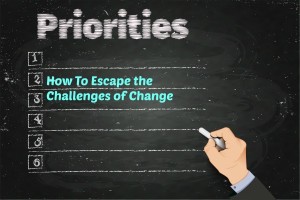Wouldn’t it be great if change was easier? Instead of facing roadblocks and challenges when you want to improve your life, wouldn’t it be nice if you could make a plan and then stick with it?
If it were that easy, New Year’s resolutions would be a piece of cake. But obviously, people struggle with change.
There are ways to make things easier, but first, let’s talk about the two biggest reasons that change is hard. Then you can use those reasons to your advantage.
 Reason #1: We’re Creatures of Habit
Reason #1: We’re Creatures of Habit
The more you do something, the easier it is to do. Your brain actually wires in shortcuts and preferences for the things you regularly do. There are millions of tasks your brain handles daily, so it only makes sense that it becomes more efficient at the repeatable stuff, right?
When you try to change, those habits and brain-wired preferences figuratively “argue” that you already have a process in place that works.
Use it to your advantage
Stopping a habit is hard, but creating a new habit that crowds it out and replaces it is relatively easy. Within just a few days, your brain recognizes that you are repeating something. Within 21 to 90 days, it becomes “wired” as a preference.
The more routine your new habit is, the faster your brain adapts to it. So, create a routine for anything you want to change and your brain will help make that new behavior a habit.
And make the routine start with something unique.
For example, if you want to begin an exercise program, the time of day you exercise, the place, and your clothes might not always be the same. But if you clap three times before you get ready and exercise, your brain will identify clapping three times as your cue to exercise. Eventually, no matter how “not into it” you feel, if you clap three times, the habit will take over and help you get ready and go.
Reason #2: We Identify with The Old Behavior
Without being aware of it, we picture ourselves in a way that makes change harder than it has to be.
For example, if you want to change your health and know you need to exercise, it will be much harder to add it to your routine and stick with it if you picture yourself as someone who hates exercise.
When a situation comes up that gives even the flimsiest excuse to miss a session, your brain will support you in skipping it. After all, that’s “who you are.”
Use it to your advantage
Picture yourself as someone who already successfully does the habit you want to develop.
For example, if you picture yourself as someone who exercises consistently, when a situation occurs that would have once been the perfect excuse for skipping a session, your brain thinks, “Wait a minute! You’re someone who exercises. You’ve got to find a way to get past this situation and be the regular exerciser you are.”
Putting It All Together
When you want to change, identify the behaviors needed to make the change. Pick 1 or 2 of them, create a unique routine, know that the first few weeks will be the hardest but that it will steadily get easier as the habit forms, and then every morning and night, picture yourself as someone who is already successful with the behavior(s).
What if the change you want isn’t easy to quantify? What if you slip up and go back to old habits? Those are great questions and I’ll talk about the answers in future blog posts.

